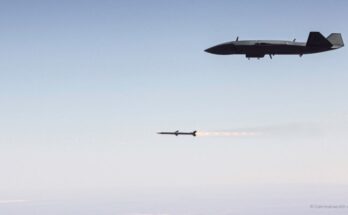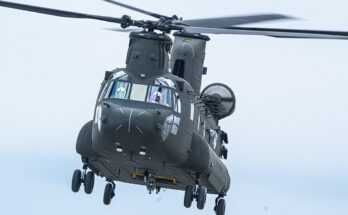
On June 11, Turkey announced that Indonesia had agreed to purchase 48 Kaan fifth-generation fighter jets, marking the first export commitment for the Turkish Aerospace (TAI)-developed aircraft. The announcement, tied to a broader defense cooperation agreement between President Prabowo Subianto and President Recep Tayyip Erdogan, lacks the force of a binding contract. Still, Erdogan hailed it as a “record-breaking” deal, despite the absence of disclosed financial details.
While Ankara celebrated the agreement as a public relations victory, the core question is whether Jakarta’s commitment is real or rhetorical. Indonesia’s fighter acquisition policy remains volatile, often shifting week to week, and its Air Force (TNI-AU) has struggled to meet long-standing modernization goals.
Since 2009, the TNI-AU has pursued an overhaul under the Minimum Essential Force (MEF) program to recover from post-1999 Western arms embargoes. Its aging fleet—comprising F-16s, F-5E/F Tigers, Su-27/30s, and BAE Hawk 209s—was to be revitalized, with a goal of operating 180 fighters by 2024. That benchmark has not been met.
Replacement of the aging Northrop F-5s took priority among the TNI-AUs fighter modernization wish-list.
The initial plan was to replace this fleet with 11 Russian-built Sukhoi Su-35s at a cost of $1.14 billion under a cash and commodity deal (items such as palm oil, coffee, tea, and rubber were offered up by Indonesia).
Having operated a mixed Sukhoi fleet since 2003, the more advanced Su-35 presented a logical successor for the TNI-AU.
However, due to Indonesian concerns about U.S. CAATSA (Countering America’s Adversaries Through Sanctions Act) legislation regarding defense and/or intelligence-related transactions with Russia, this agreement was ultimately dropped.
Instead, the Indonesian MoD pursued two alternatives concurrently to replace its F-5 fleet: the Rafale from France’s Dassault and the Boeing F-15EX Advanced Eagle (Eagle II).
On February 10, 2022, Indonesia announced an order for 42 French-built Dassault Rafale multirole combat aircraft, with a first phase firm order of six fighters. Contracts for the remaining 36 units were placed in August 2023 and January 2024, each for 18 fighters apiece. Delivery of the first six units is expected to begin in February 2026.
Then on May 28 of this year, during a visit to the country by French President Emmanuel Macron, Indonesia inked a Letter of Intent (LOI) with Paris for the potential acquisition of another 18 Rafales.
Yet some reports – whatever their credibility – indicate Indonesia may be wavering on its commitment to the Rafale following the performance of French-made systems used by the Indian Air Force (IAF) against Pakistani forces during the recent limited fighting between the two countries over May 7-10.
Meanwhile, questions remain as to how the TNI-AU will fill out the remainder of its planned fighter capability beyond the Rafale.
Though Indonesia tapped the Rafale as one fighter solution to replace the F-5, it kept the door open for a purchase of Boeing’s F-15EX (with the Indonesian derivative being referred to as F-15ID) and signed a Memorandum of Understanding (MoU) for the acquisition of 24 units on August 21, 2023.
However, forward progress on a finalized deal appears stalled.
Instead, a surprise contender has emerged in China’s J-10 “Vigorous Dragon” single-engine, multirole fighter from Chengdu. This interest in the fighter predates the use by Pakistan’s Air Force of the J-10 against India back in May, a skirmish that bolstered the Chinese aircraft’s reputation due to reports that one these units down an IAF Rafale.
Indonesia officials have confirmed that discussions regarding the J-10 remain ongoing, with price assumed as a crucial factor in its favor. This becomes even more important when considering that the Indonesian Defense Ministry’s financial bandwidth – even via foreign loan assistance, a traditionally utilized avenue – appears to be too limited to splash out on multiple combat aircraft purchases.
Indonesia’s interest in a Chinese-built fighter jet appears an odd turn as China has taken an aggressive military approach to its broad claims in the South China Sea region. This has included penetrating into Indonesia’s exclusive economic zone (EEZ) around the Natuna Islands. So, while Jakarta’s non-aligned security policy would ostensibly open the country to military imports from any provider, accepting key hardware from a potential aggressor appears at odds with a sensible procurement and force structure-building model.
Further complicating the overall picture is Indonesia’s ongoing partnership with South Korea on the KF-21 Boromae, a new twin-engine, “4.5-generation” fighter with high-end avionics systems. Initial production of the first 20 units by Korea Aerospace Industries (KAI) is underway.
Indonesia’s arrangement regarding the Indonesian Fighter Xperiment (IFX) project (so termed from the Indonesian side) was signed on January 7, 2016.
Under the deal Indonesia is to finance 20 percent of developmental costs (roughly $1.2 billion) and in return receive one fighter prototype as well as access to technical data and information involved in the aircraft program. But persistent missed payments and shifting goals prompted the two countries to redefine their arrangement at the IndoDefense show in Jakarta last week, with Indonesia’s revised remaining financial commitment falling to around $440 million (to date Indonesia has invested around $290 million into the KF-21 program).
Indonesia stated goal remains the purchase of 50 KF-21s, or enough to equip three TNI-AU fighter squadrons of 16-22 aircraft apiece. The Indonesian side reaffirmed that target to South Korea’s Defense Acquisition Program Administration (DAPA) at the IndoDefense show, downplaying to the media the significance of its agreement with TAI for the Kaan fighter purchase. Noteworthy in that agreement was wording that deliveries of the Kaan would occur within 120 months (10 years). Meaning the horizon for the purchase and delivery of these aircraft is not immediate.
For Indonesia, reliance upon a single military supplier and any one country as security guarantor is regarded as a strategic weakness and restrictive on the country’s sovereignty and policy flexibility. The TNI-AU combat aircraft fleet and its procurement interests are therefore reflective of the country’s overall non-alignment outlook. Turkey simply represents yet another potential link to the larger military supply chain.
From the Turkish perspective, clinching an export partner for its nascent fighter program represents a feather in the cap of its military aerospace sector, which has already benefited from the strong success of its armed uncrewed aerial systems (UASs) in theaters of conflict ranging from Nagorno-Karabakh (Azerbaijan) to Libya and now Ukraine.
Achieving a breakthrough into the fifth-generation fighter market would mark a significant stride for Turkey’s rapidly advancing defense industry. A mockup of the Turkish fighter (then referred to as TF-X) was first unveiled at the Paris Air Show in 2019. Since then, the first prototype completed its maiden flight in 2024, with initial deliveries expected to kick off in 2028.
Other countries have evinced interest in the twin-engine Kaan, including Azerbaijan (which inked a protocol agreement in July 2023 to join the program on the development front), Pakistan, and an unnamed Gulf country.
Still, to date only Indonesia has signed an agreement to purchase the fighter.
Yet Indonesia’s defense ambitions continue to outpace its budget. With defense spending below 1% of GDP and only $4.2 billion allocated for 2025 procurement, its ability to support multiple high-end acquisitions is limited. In-kind payment plans—such as commodity swaps for palm oil and rubber—may help, but sustaining a diverse fleet remains fiscally daunting.
Until Indonesia increases defense funding, the TNI-AU may be forced to scale back, possibly relying on second-hand or lower-generation aircraft to fill gaps. In that case, Turkey’s proclaimed export triumph could prove more symbolic than real.
Dan Darling is Forecast International’s director of military and defense markets. In this role, Dan oversees a team of analysts tasked with covering everything from budgeting to weapons systems to defense electronics and military aerospace. Additionally, for over 17 years Dan has, at various times, authored the International Military Markets reports for Europe, Eurasia, the Middle East and the Asia-Pacific region.
Dan's work has been cited in Defense News, Real Clear Defense, Asian Military Review, Al Jazeera, and Financial Express, among others, and he has also contributed commentary to The Diplomat, The National Interest and World Politics Review. He has been quoted in Arabian Business, the Financial Times, Flight International, The New York Times, Bloomberg and National Defense Magazine.
In addition, Dan has made guest appearances on the online radio show Midrats and on The Media Line, as well as The Red Line Podcast, plus media appearances on France 24 and World Is One News (WION).



